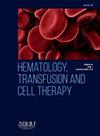Pediatric venous thromboembolism: incidence and patient profile in a single Brazilian institution
IF 1.8
Q3 HEMATOLOGY
引用次数: 0
Abstract
Background
As the diagnosis of Pediatric venous thromboembolism has dramatically increased in recent decades, this study aims to evaluate these patients, determining the incidence and describing their biological and clinical characteristics.
Methods
An observational, cross-sectional study was conducted at a Brazilian quaternary hospital between January 2022 and February 2023. Under 18-year-old hospitalized patients with a confirmed diagnosis of venous thromboembolism were included, while those with arterial or chronic thrombosis were excluded. Data on biological and clinical characteristics, diagnosis and treatment were evaluated. A descriptive data analysis was performed and the incidence of hospital-associated thrombosis was calculated.
Results
Thirty-nine pediatric patients were evaluated. The incidence of hospital-associated thrombosis was 19.9 cases per 10,000 pediatric hospitalizations. Median age at diagnosis was four months (range: 12 days-17 years). Most of the patients (66.7%) were asymptomatic, with venous thromboembolism being diagnosed incidentally. In all cases, at least one risk factor was identified and in 74.6% of cases four or more factors were present. The principal risk factors were the presence of a central venous catheter (89.7%) and infection (89.7%). Thrombogenic comorbidities, particularly congenital heart disease, were present in 48.7% of patients.
Conclusions
The incidence of venous thromboembolism found in the present study was lower than rates reported in developed countries. The principal characteristics of this sample were a greater frequency of central venous catheter and infection as risk factors, and the fact that the cases consisted mainly of newborns and individuals with heart disease.
小儿静脉血栓栓塞症:巴西一家医疗机构的发病率和患者概况。
背景:近几十年来,小儿静脉血栓栓塞症的诊断率急剧上升:近几十年来,小儿静脉血栓栓塞症的诊断率急剧上升,本研究旨在对这些患者进行评估,确定其发病率并描述其生物和临床特征:方法:2022 年 1 月至 2023 年 2 月期间,在巴西一家四级医院进行了一项横断面观察研究。研究对象包括确诊为静脉血栓栓塞症的 18 岁以下住院患者,但不包括动脉血栓或慢性血栓患者。对生物和临床特征、诊断和治疗数据进行了评估。对数据进行了描述性分析,并计算了医院相关血栓形成的发生率:结果:共评估了 39 名儿科患者。结果:共对 39 名儿科患者进行了评估,医院相关血栓症的发病率为每万名住院儿科患者中有 19.9 例。确诊时的中位年龄为 4 个月(范围:12 天-17 岁)。大多数患者(66.7%)没有症状,静脉血栓栓塞症是偶然诊断出来的。在所有病例中,至少发现了一个风险因素,74.6%的病例存在四个或四个以上的风险因素。主要风险因素是中心静脉导管(89.7%)和感染(89.7%)。48.7%的患者存在血栓形成合并症,尤其是先天性心脏病:结论:本研究发现的静脉血栓栓塞症发病率低于发达国家报告的发病率。该样本的主要特点是,中心静脉导管和感染是更常见的风险因素,而且病例主要由新生儿和心脏病患者组成。
本文章由计算机程序翻译,如有差异,请以英文原文为准。
求助全文
约1分钟内获得全文
求助全文
来源期刊

Hematology, Transfusion and Cell Therapy
Multiple-
CiteScore
2.40
自引率
4.80%
发文量
1419
审稿时长
30 weeks
 求助内容:
求助内容: 应助结果提醒方式:
应助结果提醒方式:


